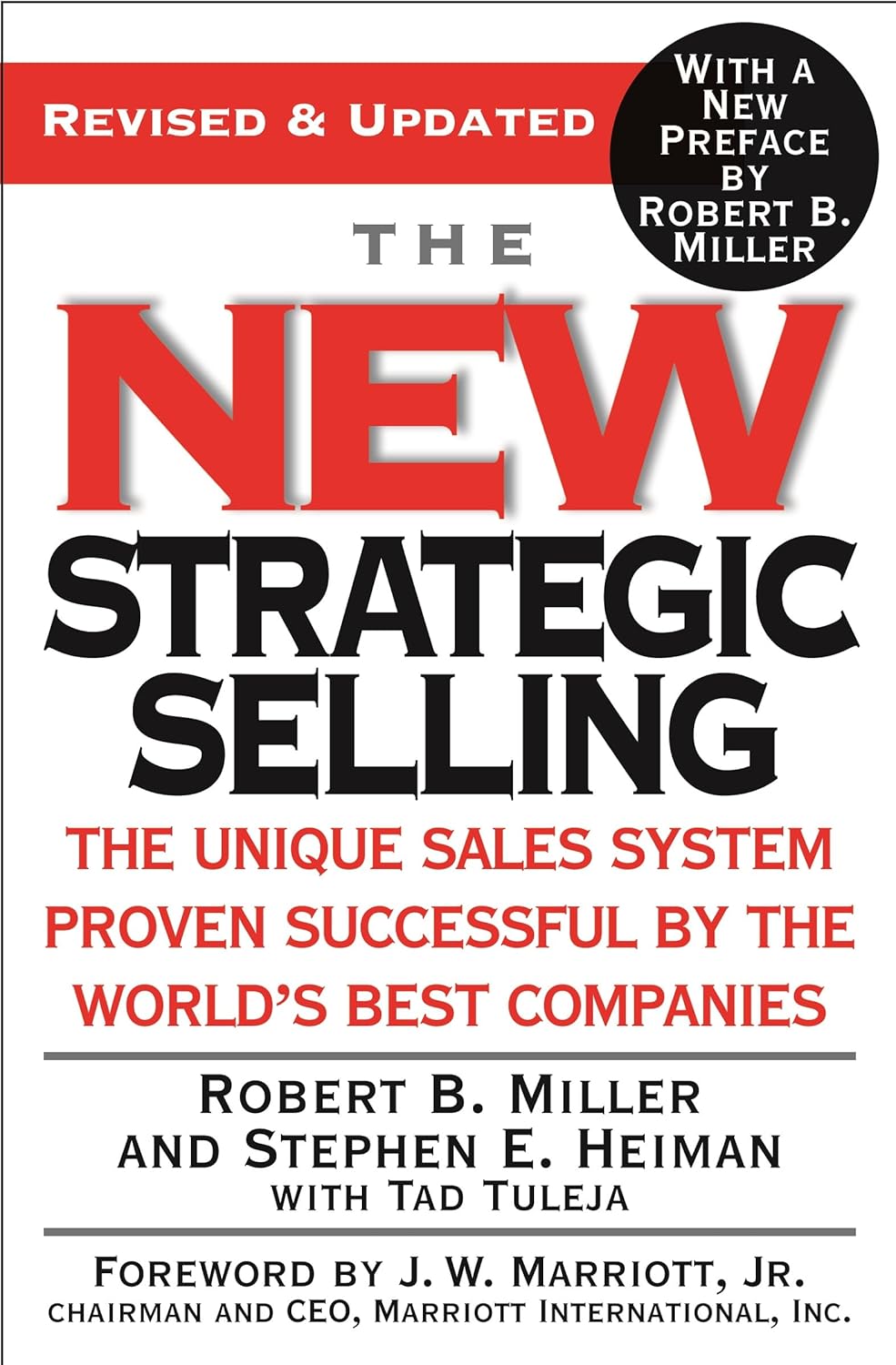![]()

The New Strategic Selling by Miller Heiman redefines B2B sales with a process-driven, win-win approach. This updated classic teaches you how to navigate complex buying teams, outmaneuver internal blockers, and win high-stakes deals without resorting to pressure tactics. Ideal for anyone selling into large organizations.
Chapters of The New Strategic Selling
The chapters of the book of The New Strategic Selling by Robert B. Miller, Stephen E. Heiman, and Tad Tuleja guide sales professionals through a systematic approach to complex sales, focusing on understanding buying influences, managing risks, and developing effective strategies for long-term success.
Each chapter systematically builds the strategic selling process, from understanding your position and key influences, through managing competition and resources, to implementing a sustainable, win-win sales approach.
Here are the key topics covered in each chapter.
Chapter 1: Successful Selling in a World of Constant Change
- Overview: Introduces the challenges of modern sales environments and the need for a strategic approach.
- Key Topics: The importance of adapting to change, recognizing evolving customer needs, and the limitations of traditional sales tactics.
Chapter 2: Strategy and Tactics Defined
- Overview: Differentiates between strategy and tactics.
- Key Topics: Explains why a long-term strategic view is essential for complex sales, and how tactics support this strategy.
Chapter 3: Your Starting Point: Position
- Overview: Discusses the importance of understanding your current position.
- Key Topics: How to assess your strengths, weaknesses, and opportunities in each sales situation.
Chapter 4: A Glance at the Strategy Blueprint: The Six Key Elements of Strategic Selling
- Overview: Introduces the core framework of the book.
- Key Topics: Overview of the six key elements: Buying Influences, Red Flags, Response Modes, Win-Results, Ideal Customer, and Sales Funnel.
Chapter 5: Key Element 1: Buying Influences
- Overview: Focuses on identifying all key decision-makers.
- Key Topics: The roles of Economic Buyer, User Buyer, Technical Buyer, and Coach in the buying process.
Chapter 6: Key Element 2: Red Flags/Leverage from Strength
- Overview: Highlights potential threats and opportunities.
- Key Topics: How to spot warning signs (Red Flags) and leverage your strengths to overcome obstacles.
Chapter 7: Buyer Level of Receptivity
- Overview: Explores how receptive buyers are to change.
- Key Topics: The importance of timing and how to approach buyers in different states of readiness.
Chapter 8: Key Element 3: The Four Response Modes
- Overview: Covers buyer responses to change.
- Key Topics: Growth Mode, Trouble Mode, Even Keel, and Overconfident Mode—and how to adapt your approach accordingly.
Chapter 9: The Importance of Winning
- Overview: Emphasizes the win-win philosophy.
- Key Topics: Why both buyer and seller must benefit for a sale to be successful.
Chapter 10: Key Element 4: Win-Results
- Overview: Focuses on delivering results that matter to the buyer.
- Key Topics: Crafting Win-Results statements and ensuring all buying influences see personal value in your solution.
Chapter 11: Getting to the Economic Buying Influence: Strategies and Tactics
- Overview: Addresses reaching the ultimate decision-maker.
- Key Topics: Tactics for identifying and engaging the Economic Buyer, who controls the budget and final approval.
Chapter 12: The Coach: Developing Your Prime Information Resource
- Overview: Explains the role of a coach in the sales process.
- Key Topics: How to identify, develop, and leverage a coach to guide you through the sale.
Chapter 13: What About the Competition?
- Overview: Discusses dealing with competitors.
- Key Topics: Strategies for differentiating yourself and managing competitive threats.
Chapter 14: Key Element 5: Ideal Customer
- Overview: Focuses on targeting the right customers.
- Key Topics: Defining your ideal customer profile to maximize sales effectiveness.
Chapter 15: Your Ideal Customer Profile: Demographics and Psychographics
- Overview: Details how to build an ideal customer profile.
- Key Topics: Analyzing demographic and psychographic data to identify your best prospects.
Chapter 16: Of Time, Territory, and Money
- Overview: Addresses resource management.
- Key Topics: How to allocate your time, territory, and budget for maximum sales efficiency.
Chapter 17: Key Element 6: The Sales Funnel
- Overview: Introduces the sales funnel concept.
- Key Topics: Managing opportunities through the funnel stages for steady, predictable revenue.
Chapter 18: Priorities and Allocation: Working the Funnel
- Overview: Explains how to prioritize and manage opportunities.
- Key Topics: Techniques for focusing on the most promising deals and allocating resources effectively.
Chapter 19: Your Action Plan
- Overview: Guides readers in creating a practical plan.
- Key Topics: Steps for implementing the strategic selling process in your own sales efforts.
Chapter 20: Strategy When You Have No Time
- Overview: Offers advice for urgent situations.
- Key Topics: Quick strategies for making progress when time is limited.
Chapter 21: Strategic Selling: A Lifetime Approach
- Overview: Encourages long-term adoption of the approach.
- Key Topics: Making strategic selling a habit for ongoing sales success and customer relationships.
